Національний музей українського народного декоративного мистецтва — один з найбільших художніх музеїв України. Розташований він на території Національного Києво-Печерського історико-культурного заповідника у приміщеннях колишніх митрополичих покоїв і прилеглої до них домовоїБлаговіщенської церкви, які є пам′ятками архітектури ХVІІІ – поч. ХХ ст.
Колекція музею була започаткована у 1899 р. як одна із складових збірки новоутвореного Міського музею старожитностей і мистецтв, перейменованого у 1904 р. у Київський художньо-промисловий і науковий музей.
Нині музейну збірку складають понад 75 тис. творів традиційного народного та професійного декоративного мистецтва України від ХV ст. до наших днів. Це різноманітні за матеріалом, формою, декоруванням і призначенням предмети домашнього вжитку, перетворені руками талановитих майстрів у високохудожні мистецькі твори. Всі вони мають яскраво визначені регіональні відмінності. У роботах професійних художників декоративного мистецтва простежуються використання усталених народних традицій і тенденція до створення складних просторових композицій образно-асоціативного змісту.
В експозиції музею, яка займає площу 1500 кв. м., представлені всі види народного мистецтва України: килимарство, ткацтво, вибійка, вишивка, кераміка, різьблення та розпис по дереву, художня обробка шкіри, рогу та металу, скло, фарфор, писанкарство, народний живопис та іконопис. Гордістю та окрасою колекції є комплекси українського народного вбрання ХІХ — поч. ХХ ст. всіх регіонів України, де в єдиному художньому ансамблі поєдналися мистецтво крою, ткання, вишивки, аплікації, вибійки, плетіння, обробки шкіри та металу. Привертають увагу традиційні жіночі прикраси: дукачі, коралі, венеціанське намисто, вироби з бісеру.
Раритетами музейної збірки є дерев’яний різьблений хрест у срібній оправі 1576 р., глиняні кахлі ХV — ХVІІІ ст., козацькі люльки та порохівниці ХVІІІ — ХІХ ст., шовкові ткані пояси ХVІІІ ст., гаптовані золотими та срібними нитками предмети церковного шитва ХVІІІ ст., гутне скло ХVІ — ХVІІІ ст., вироби провідних порцелянових і фаянсових підприємств України ХVІІІ — ХІХ ст.: Києво-Межигірської фаянсової фабрики та Волокитинського фарфорового заводу.
Музей володіє найбільшою в Україні збіркою творів народного художника України Марії Примаченко (1909 — 1997), яка складає понад 500 казково-фантастичних композицій. В окремій залі представлені живописні полотна народного художника України Катерини Білокур (1900 — 1961). Вони по праву вважаються перлиною музейної колекції і належать до скарбниці світового мистецтва.
Різноманітні виставки систематично знайомлять шанувальників народного декоративного мистецтва з роботами сучасних митців та з творами, що зберігаються у фондах музею.
Більш докладну інформацію Ви знайдете на відповідних сторінках цього сайту. Представлені на ньому матеріали регулярно оновлюються та доповнюються.
Fonte: @edisonmariotti #edisonmariotti
colaboração: Ольга Єфремова
Cultura e conhecimento são ingredientes essenciais para a sociedade.
A cultura é o único antídoto que existe contra a ausência de amor.
Vamos compartilhar.
--in
The National Museum of Ukrainian Folk Decorative Art is one of the largest art museums of Ukraine. Its collection comprises of over 80 thousand items of the traditional folk and professional decorative art of Ukraine since 15 till early 21 century.
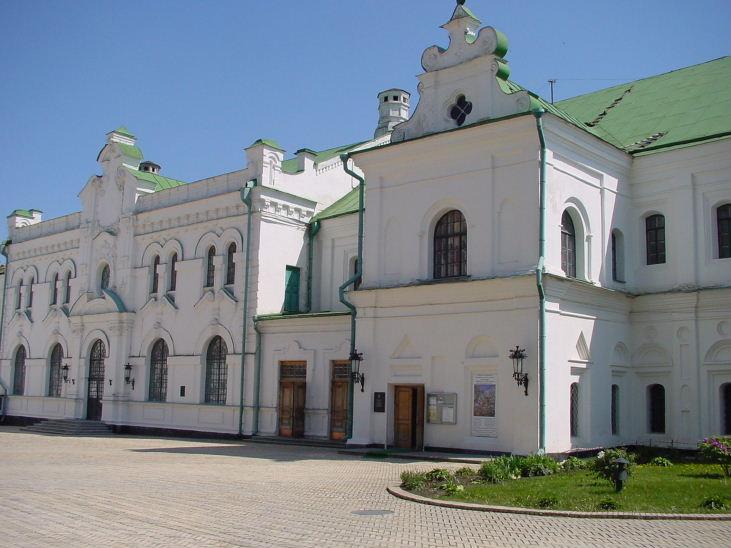
National Museum of Ukrainian Folk Decorative Art
The history of the museum collection started in 1899, when the first public museum – the City Museum of ancientries and arts. It was located in a specially built premise on the Oleksandrovska street (today it is 6, Grushevska street).
During the next decades the museum several times changed its name. It was Kyiv art - industrial and scientific museum named after the Russian Tsar Mykola Oleksandrovych, the First state museum, the All-Ukrainian Historical Museum named after Taras Shevchenko, Kyiv state museum of Ukrainian arts. In 1936 its historical and archeological collection was served as the basis of the State historical museum (today it is the National museum of the history of Ukraine). In 1954 the collection of folk art and artistic craft became an independent segment and was housed as a branch on the territory of the Kyiv-Pechersk Lavra in the metropolite chambers and adjacent home church of Annunciation (historic landmark of 18 – early 20 century).
In 1964 the branch was turned into the independent institution named as the State museum of the Ukrainian decorative art. In 2010 the museum was granted the National status.
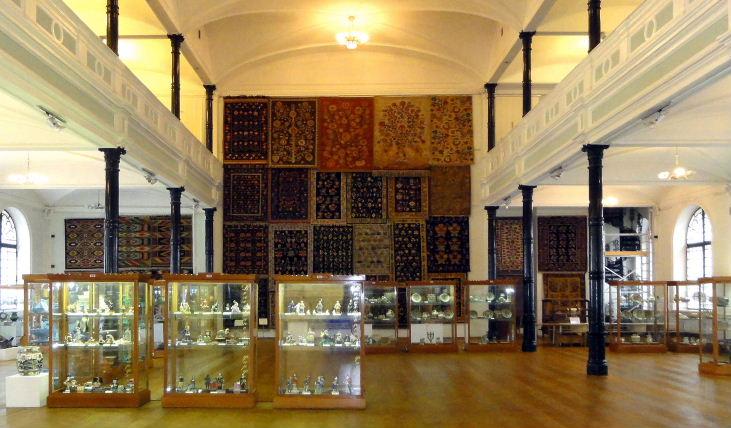
One of museum exhibition halls
The museum collection represents all types of traditional folk art of Ukraine – carpet weaving, fabric weaving, vybiyka (folk decorative printing on fabric), embroidery, pottery, wood carving and painting, artistic leather, bone and metal working, art glass, porcelain, glazed pottery, enamel, decorative painting, vytynanka (delicate ornament paper patterns), batik, painted Easter eggs, folk painting and icon painting.
The museum collected diverse in material, form, décor and meaning items of family life that have been transformed by the talented craftsmen into highly artistic work of art. All of them demonstrate highly expressive national and regional peculiarities.
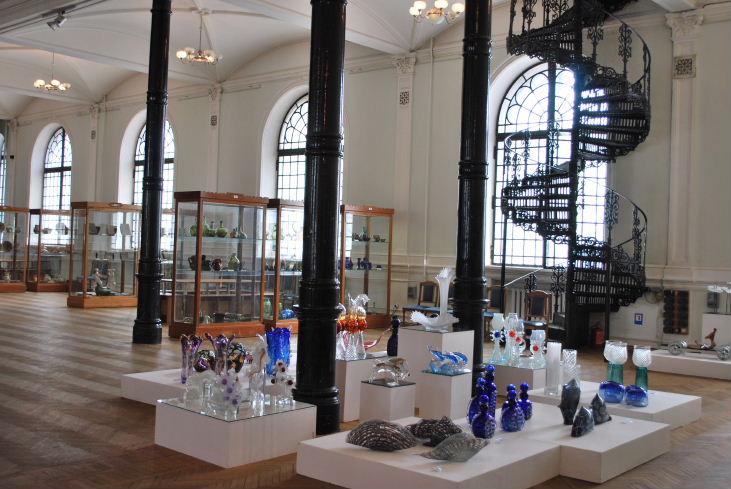
Exhibition of art glass
The museum possesses a significant collection of art works created by the professional artists of Ukrainian decorative art that trace the folk traditions and tendencies to complex spatial compositions of the image bearing associative content.
The collection of carpets that encompasses over a thousand works of art since 18 till early 21 century is an ample evidence of the high-level and original artistic culture of the Ukrainian people which enables to trace the process of formation of a single national style, demonstrates the diversity of the carpet ornamentation from different centers. The rarities of the collection include the carpets from the Volyn (1782), Poltava (1831), Podillya (1871) regions, and carpet dated back to the 18 century from the sepulture of hetman Danylo Apostle.
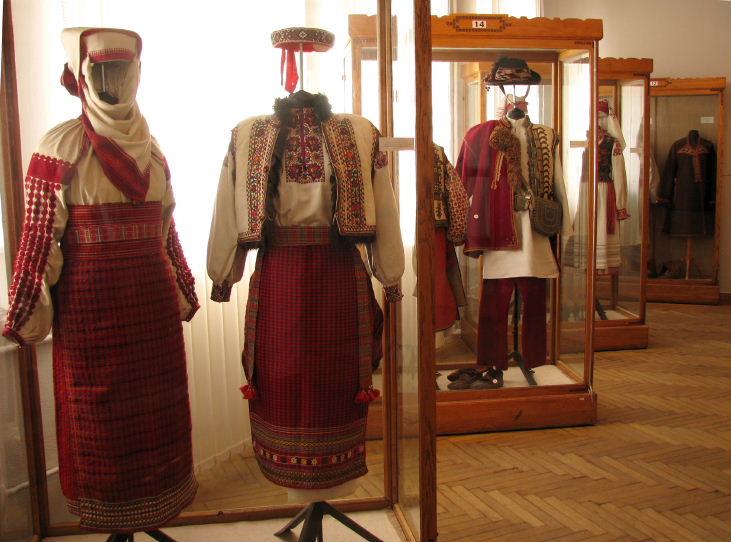
Exhibition of traditional clothes
Over seven thousand items form the collection of artistic clothes (18-early 21 century). Beautiful in pattern and color the fabric samples (ritual towels, tablecloths, bench decorative cloths, linen, vereta (interior decorative fabric), etc.) decorated tables, benches, chests, beds and icon shelves. Different fabric items were used as the elements of the folk garments. The set of silk belts embroidered with golden threads that served as an accessory for the overclothes of rich petty bourgeois and Cossack top-ranking officials is one of the most valuable parts of the collection.

Collection of traditional clothes (19 – early 20 century);
Ritual towels. 
The most numerous collection of the museum is devoted to the embroidery. It encompasses over twenty eight units of issue. Among others one can see devotional articles richly embroidered with silk, gold and silver threads (vozdushka - a peculiar napkin in the shape of cross or square used to cover the chalice, covers, fragments of ph(a)elonions and inner rasons) from the 18 till early 19 century). The works cannot but impress with high technical skills of their executors, ornamental compositions beauty and sophisticated colours. Among large diversity of the items that are different in form, décor, execution and purpose, the leading place is taken by the embroidered rooshnyks (ritual towels).
The museum is proud of Ukrainian traditional clothes (19 – early 20 century) from all regions of Ukraine that mix the art of cut, weaving, embroidery, appliqué, braiding, leather and metal working. Every suit in addition to multiple common features has a range of differences. They are related to the components, cut décor, how the individual details or parts are tied, accessories available, etc. The chemise decorated with the embroidered or woven patterns has always been a common element of ladies’ wear in all regions of Ukraine. It displayed the variety of headwear (ochipky or bonnets, namitky – ladies’ headwear put around the bonnet, shawls) and the way they are tied. The glad rags were complemented with adornments like coral, glass (venetian), amber necklace, gerdan (necklace handmade of glass beads), sylianka (necklace handmade of beads in the shape of collar), dukach (necklace made of coins or medallions), etc.
The pottery – over 14 thousand items from 15 till early 21 century- occupies the significant place in the museum collection. One can enjoy different it form, décor and purpose household articles, figured vessels in the shape of wild and domestic animals, birds, toys, etc. The terracotta tiles since 15 till 17 centuries decorated with raised ornament are unique articles of art. The 20th century pottery encompasses works of leading pottery plants and works of authorship created by professional pottery artists of Ukraine.
Over six thousand works are assembled in the collection of wood carving and painting, bone, leather and metal working. The wood was the most available material in the everyday life of Ukrainian people in recent times. It was used for making carts and sledges, cases of windows and doors, pieces of furniture (tables, benches, chests, plate shelves), shelves for icons, toys, etc. The wooden carved set in silver cross (1576) from the Volyn region is the earliest dated museum article. The collection of horn and bone Cossacks’ gun-powder flasks (late 17 – 19 centuries) with engraved ornament is one of the largest in Ukraine.
The unique collection of porcelain and glazed pottery comprises of more than six thousand works of art dated to 18 – 20th centuries. They present the most beautiful products of all Ukrainian porcelain and ceramic works. The museum possesses the rare samples from the Koretsky porcelain factory (1784-1831), that trace the classicism-style features. The Baranivka porcelain factory (founded in 1803) products are considered to be the best samples of the Empire style. The majority of products manufactured at the Volokytyn porcelain works (1839-1861) are marked with the “second rococo” trend that was very popular in the middle of 19 century.
The museum is proud of the biggest in Ukraine collection of Kyiv – Mezhygirya porcelain factory (1798-1876). The wide assortment, high technical level and peculiar style of décor are typical to its products.
The art glass collection (16-20th centuries) contains over four thousand items and the most interesting samples of the so called Gutne glass. The “guta” meant a small artisan workshop that produced glass and manufactured different vessels like shtoffs, carafe, kegs, goblets, cups, vases, etc. decorated by moldings, engravings, enamel paintings.
The glass figure vessels in the shape of bears, lambs, geese, ducks, birds that have been very popular among the people attract attention of visitors. The glass engraved goblet designed in 1731 for the prince Mykhaylo Servatsiy Korybut Vishnevetsky is considered to be the unique work of art.
The collection presents beautiful works of artists from the second half of 20 century that worked at the leading glass works of Ukraine – Kyiv and Lviv art glass plants with their peculiar deep understanding of ancient traditions and search for new forms of artistic expressiveness.
The collection of painted Easter eggs encompasses more than four thousand units since 19 till early 21 century. The painted Easter egg or pysanka is a peculiar phenomenon of Ukrainian culture that revealed the high spirituality of the people and its philosophic understanding of life in the most pronounced way. The museum houses the collection of painted Easter eggs from all regions of Ukraine with peculiar pattern and colour features.
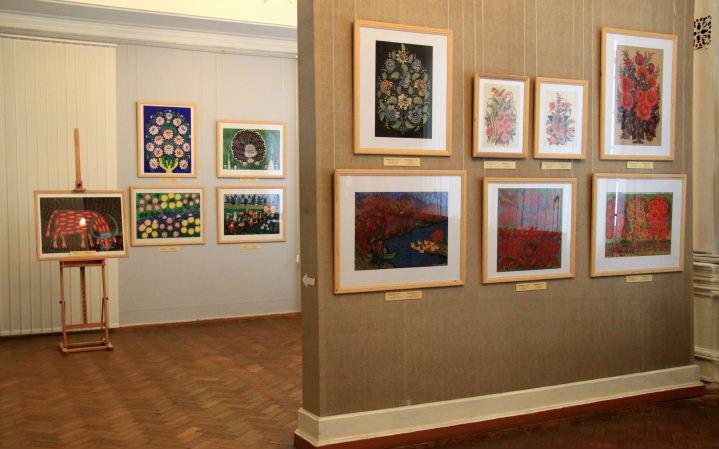
Exhibition of decorative painting
The collection of decorative painting, folk art, icon paintings, vytynanka (delicate ornament paper patterns), - over six thousand articles since 18 till early 21 century is rich and diverse. The decorative ornament compositions on paper developed from the wall paintings of dwellings that were very popular in some localities of Ukraine, especially in Dnipropetrovsk area. It was nowhere but here, especially in the village of Petrykivka the folk painting art got the peculiar development and became known as “Petrykivka painting”. G. Sobachko-Shostak, T. Pata, P. Vlasenko, M. Tymchenko were unsurpassed artists of the decorative genre.
The museum possesses the largest in Ukraine collection of works painted by the People’s painter of Ukraine Maria Pryimachenko (1909 – 1997) that encompasses more than six hundred fantastic and fairy tale compositions. Maria Prymachenko is among Top-10 primitive artists of the world.
Thirty seven canvases of the People’s painter of Ukraine Kateryna Bilokur (1900 – 1961) whose artistic heritage by rights belongs to the treasury of the world art are considered to be the pearl of the museum collection.
--br via tradutor do google
O Museu Nacional de Arte popular do ucraniano decorativa é um dos maiores museus de arte da Ucrânia. Seu acervo é composto por mais de 80 mil itens do folk tradicional e arte decorativa profissional da Ucrânia desde 15 até início do século 21. Museu Nacional de Arte popular do ucraniano decorativa A história da coleção do museu começou em 1899, quando o primeiro museu público - o Museu da Cidade de ancientries e artes. Ele foi localizado em uma premissa especialmente construído na rua Aleksandrovska (hoje é 6, Grushevska rua).
Durante as próximas décadas os tempos museu várias mudou seu nome. Foi Kyiv arte - Museu industrial e científica em homenagem ao czar russo Mykola Oleksandrovych, o primeiro museu do estado, o All-ucraniana Museu Histórico nomeado após Taras Shevchenko, Kiev museu do estado das artes da Ucrânia.
Em 1936, seu acervo histórico e arqueológico foi servido como base para o museu histórico do Estado (hoje é o museu nacional da história da Ucrânia). Em 1954, a coleção de arte popular e artesanato artístico tornou-se um segmento independente e foi alojado como um ramo no território do Kyiv-Pechersk Lavra nas câmaras Metropolitano e da igreja casa adjacente de aviso (marco histórico de 18 - início de 20 do século). Em 1964, a agência foi transformada na instituição independente nomeado como o museu do estado da arte decorativo ucraniano. Em 2010 o museu foi concedido o estatuto nacional. Uma das exposições do museu salões do acervo do museu representa todos os tipos de arte popular tradicional da Ucrânia - tecelagem de tapetes, tecelagem tecido, vybiyka (popular impressão decorativa em tecido), bordado, cerâmica, escultura em madeira e pintura, couro artístico, ósseas e tratamento de metais, arte em vidro, porcelana, cerâmica vitrificada, esmalte, pintura decorativa, vytynanka (delicados padrões de papel ornamento), batik, ovos de Páscoa pintados, pintura popular e ícone da pintura.
O museu recolhidos diversos em materiais, forma, decoração e significado itens da vida familiar que foram transformadas pelos artesãos talentosos para o trabalho de elevado nível artístico da arte. Todos eles demonstram particularidades nacionais e regionais altamente expressivos. Exposição de arte em vidro O museu possui uma coleção significativa de obras de arte criadas por artistas profissionais de arte decorativo ucraniano que traçar as tradições e tendências populares a composições espaciais complexos da imagem Rolamento de conteúdo associativo. A coleção de tapetes que abrange mais de mil obras de arte desde 18 até o início do século 21 é uma evidência ampla de Alto Nível e da cultura artística original do povo ucraniano que permite rastrear o processo de formação de um único estilo nacional, demonstra a diversidade da ornamentação tapete de diferentes centros. As raridades da coleção incluem os tapetes do Volyn (1782), Poltava (1831), Podillya (1871) regiões, e carpete remontam ao século 18 a partir da sepultura de hetman Danylo Apóstolo. Exposição de roupa tradicional Mais de sete mil itens formam a coleção de roupas artísticas (18 e início do século 21). Bonita em cor e padrão das amostras de tecido (toalhas rituais, toalhas de mesa, banco panos decorativos, linho, vereta (tecidos de decoração de interiores), etc.) decorados mesas, bancos, baús, camas e ícone prateleiras.
Diferentes peças de tecido foram usados como os elementos das roupas folclóricas. O conjunto de cintos de seda bordados com fios de ouro que serviu como um acessório para os overclothes de rico pequeno-burguês e cossacos funcionários de alto escalão é uma das partes mais valiosas da coleção. Coleção de roupas tradicionais (19 - início de 20 do século); toalhas ritual. A mais numerosa colecção do museu é dedicado ao bordado. Ela engloba mais de vinte e oito unidades de emissão. Entre outros pode-se ver artigos devocionais ricamente bordados com fios de seda, de ouro e prata (vozdushka - um guardanapo peculiar em forma de cruz ou quadrado usado para cobrir o cálice, cobre, fragmentos de ph (a) elonions e rasons internas) do 18 até o início do século 19). As obras não podem deixar de impressionar com altas habilidades técnicas dos seus executores, composições ornamental beleza e cores sofisticadas. Entre grande diversidade de itens que são diferentes na forma, decoração, execução e finalidade, o lugar principal é tomada pelos rooshnyks bordados (toalhas ritual).
O museu se orgulha de roupa ucraniana tradicionais (19 - início do século 20) de todas as regiões da Ucrânia que misturam a arte de corte, tecelagem, bordados, apliques, trança, couro e trabalho de metais. Cada naipe, além de várias características comuns tem uma gama de diferenças. Eles estão relacionados com os componentes, corte decor, como os detalhes individuais ou partes estão vinculados, acessórios disponíveis, etc. A chemise decorado com os padrões de bordados ou tecidos sempre foi um elemento comum do desgaste das senhoras em todas as regiões da Ucrânia. É apresentado a variedade de chapelaria (ochipky ou capotas, namitky - headwear das senhoras colocar em volta do gorro, xales) ea forma como eles estão vinculados. Os trapos alegres foram complementadas com adornos como o coral, vidro (Veneza), colar de âmbar, Gerdan (artesanal colar de pérolas de vidro), sylianka (artesanal colar de pérolas em forma de anel), dukach (colar feito de moedas ou medalhões), etc. a cerâmica - mais de 14 mil itens de 15 até o início 21 Century ocupa o lugar de destaque na coleção do museu. Pode-se desfrutar diferente forma que, decoração e artigos de uso doméstico propósito, figurado vasos em forma de animais selvagens e domésticos, aves, brinquedos, etc. As telhas de terracota desde 15 até 17 séculos decorados com ornamento levantadas são artigos de arte únicas. A cerâmica do século 20 abrange obras de plantas e trabalhos de autoria criados por artistas de cerâmica profissional da Ucrânia cerâmica principais. Mais de seis mil obras são montados na coleção de escultura em madeira e pintura, osso, couro e trabalho de metais. A madeira foi o material mais disponível na vida cotidiana das pessoas da Ucrânia nos últimos tempos. Ele foi usado para fazer carroças e trenós, casos de janelas e portas, peças de mobiliário (mesas, bancos, caixas, prateleiras de chapa), prateleiras para ícones, brinquedos, etc.
A madeira entalhada definido em cruz de prata (1576) a partir do Volyn região é o mais antigo artigo museu datado. A coleção de frascos de pólvora chifre e osso 'cossacos (final 17 - 19 séculos) com o ornamento gravado é uma das maiores na Ucrânia. A colecção única de porcelana e cerâmica vitrificada é composta por mais de seis mil obras de arte datadas de 18 - 20 séculos. Eles apresentam os produtos mais bonitos de toda a porcelana ucraniana e obras de cerâmica. O museu possui as amostras raras a partir da fábrica de porcelana Koretsky (1784-1831), que traçar as características de estilo classicismo. A fábrica de porcelana Baranivka (fundada em 1803) produtos são considerados os melhores amostras do estilo Império. A maioria dos produtos fabricados na fábrica de porcelana Volokytyn (1839-1861) são marcadas com a tendência "segunda rococó", que era muito popular no meio do século 19. O museu se orgulha de o maior na Ucrânia coleção de Kyiv - fábrica de porcelana Mezhygirya (1798-1876). A grande variedade, alto nível técnico e estilo peculiar de decoração são típicos de seus produtos. A coleção de arte de vidro (séculos 16-20th) contém mais de quatro mil itens e as amostras mais interessantes do chamado vidro Gutne.
O "guta" significava uma pequena oficina artesanal que produziu vidro e fabricados diferentes embarcações como shtoffs, Garrafa de Água, barris, taças, copos, vasos, etc. decorados por molduras, gravuras, pinturas de esmalte. Os vasos figura de vidro em forma de ursos, cordeiros, gansos, patos, aves que têm sido muito popular entre as pessoas atrair a atenção dos visitantes. O cálice de vidro gravado projetado em 1731 para o príncipe Mykhaylo Servatsiy Korybut Vishnevetsky é considerada a obra de arte única. A coleção apresenta belas obras de artistas da segunda metade do século 20, que trabalhou nas obras de vidro que levam da Ucrânia - Kiev e plantas de vidro de arte Lviv com sua profunda compreensão peculiar de antigas tradições e procurar novas formas de expressividade artística. A coleta de ovos de Páscoa pintados abrange mais de quatro mil unidades desde 19 até início do século 21. O ovo de Páscoa pintado ou pysanka é um fenômeno peculiar da cultura ucraniana, que revelou a alta espiritualidade das pessoas e da sua compreensão filosófica da vida da forma mais pronunciada.
O museu abriga a coleção de ovos de Páscoa pintados de todas as regiões da Ucrânia com recursos de padrão e cores peculiares. Exposição de pintura decorativa A coleção de pintura decorativa, arte popular, pinturas de ícones, vytynanka (delicados padrões ornamento de papel), - mais de seis mil artigos desde 18 até início do século 21 é rica e diversificada. As composições ornamento decorativo no papel desenvolvido a partir das pinturas de parede de habitações que eram muito populares em algumas localidades da Ucrânia, especialmente na área Dnipropetrovsk. Não havia nenhum lugar, mas aqui, especialmente na vila de Petrykivka a arte da pintura popular tem o desenvolvimento peculiar e tornou-se conhecido como "pintura Petrykivka". G. Sobachko-Shostak, T. Pata, P. Vlasenko, M. Tymchenko eram artistas insuperável do gênero decorativo.
O museu possui a maior na Ucrânia coleção de obras pintadas pelo pintor Popular da Ucrânia Maria Pryimachenko (1909 - 1997), que abrange mais de seiscentas composições conto fantástico e fadas. Maria Prymachenko está entre top-10 artistas primitivos do mundo. Trinta e sete telas do pintor Popular da Ucrânia Kateryna Bilokur (1900 - 1961), cujo património artístico por direitos pertence ao tesouro da arte mundial são considerados como a pérola da coleção do museu.




Nenhum comentário:
Postar um comentário